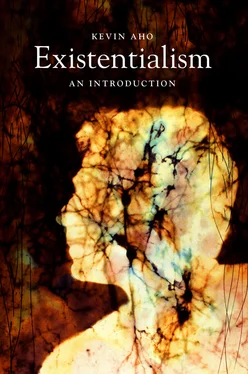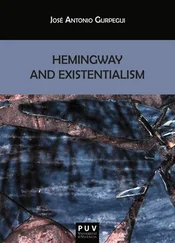Kevin Aho - Existentialism - An Introduction
Здесь есть возможность читать онлайн «Kevin Aho - Existentialism - An Introduction» весь текст электронной книги совершенно бесплатно (целиком полную версию без сокращений). В некоторых случаях можно слушать аудио, скачать через торрент в формате fb2 и присутствует краткое содержание. Год выпуска: 2013, ISBN: 2013, Издательство: Polity, Жанр: Философия, на английском языке. Описание произведения, (предисловие) а так же отзывы посетителей доступны на портале библиотеки ЛибКат.
- Название:Existentialism: An Introduction
- Автор:
- Издательство:Polity
- Жанр:
- Год:2013
- ISBN:978-0745651422
- Рейтинг книги:3 / 5. Голосов: 1
-
Избранное:Добавить в избранное
- Отзывы:
-
Ваша оценка:
- 60
- 1
- 2
- 3
- 4
- 5
Existentialism: An Introduction: краткое содержание, описание и аннотация
Предлагаем к чтению аннотацию, описание, краткое содержание или предисловие (зависит от того, что написал сам автор книги «Existentialism: An Introduction»). Если вы не нашли необходимую информацию о книге — напишите в комментариях, мы постараемся отыскать её.
Existentialism: An Introduction
Existentialism: An Introduction — читать онлайн бесплатно полную книгу (весь текст) целиком
Ниже представлен текст книги, разбитый по страницам. Система сохранения места последней прочитанной страницы, позволяет с удобством читать онлайн бесплатно книгу «Existentialism: An Introduction», без необходимости каждый раз заново искать на чём Вы остановились. Поставьте закладку, и сможете в любой момент перейти на страницу, на которой закончили чтение.
Интервал:
Закладка:
Levinas suggests that the essential aspect of our intersubjective relations cannot be accessed by thought. It is, rather, felt in the pre-reflective immediacy of the face-to-face encounter, where I sense the other person addressing me and I am called to respond to that particular person. In Totality and Infinity , Levinas describes ‘the face’ ( le visage ) of the other not as a thing or object to be conceptualized, but as a pure expression of “defenselessness,” “nudity,” and “vulnerability” (1969, 199) that is largely hidden from me under the veil of everyday propriety and social convention. In this sense, the face-to-face encounter is a rupture or breach in the flow of ordinary life that reveals a layer of interpersonal relation that demands something of me, burdening me with responsibility for the other. It is a fundamental ethical-religious event that affects me, calling me to the other in a way that is prior to any conscious reflection about who or what the other is. This is why Levinas says, “The face resists possession, resists my powers,” but it nonetheless “speaks to me” (197–198). Encountering the other in terms of this raw defenselessness and vulnerability, as a “relation without relation,” is what Levinas calls “religion” (80). Of course, ‘religion’ here does not refer to institutional practices or obeying ‘Articles of Faith.’ It refers to a relation, where I am, in my ordinary life, called to respond to and accept the other as a particular person who is vulnerable and dependent on me, and it is this relation that underlies all that is fundamental and genuine to religious or ethical life (Morgan 2011, 62).
Levinas's use of the term ‘face’ helps illuminate his allegiance to existentialism. Instead of the approaching the other from a standpoint of detachment and objectivity, the face-to-face encounter puts us squarely in the experiential world, where the other is not an abstraction but a concrete and particular person. And of all the aspects of the other's embodied presence, none is more vividly expressive than the face. Through the face, and especially the eyes, we witness the other's needs, his or her anguish, sorrow, and joy, and this witnessing underlies all of our everyday social interactions. In this regard, the face of the other has the power to draw me out of my own egoistic concerns, saying ‘ no ’ to my self-interests by revealing the other person as defenseless, dependent, and vulnerable. “The absolute nakedness of a face, the absolute defenseless face, without covering clothing or mask,” writes Levinas, “[that] is what opposes my power over it. … The being that expresses itself, that faces me, says no to me by his very expression. … The face is the fact that a being affects us not in an indicative, but in an imperative” (1998, 21). The face, then, represents an expressive imperative, an affective command or plea to be responsible to the other, a plea that is prior to any moral law or utilitarian calculus. What this reveals is that our everyday being-in-the-world is already rooted in the pre-reflective ethical discourse of the face-to-face, a discourse that is largely covered over by the masks of social convention and is taken for granted or “presupposed” (18) by the impersonal ethical systems of traditional philosophy. This is why ethics, for Levinas, is to be regarded as ‘first philosophy.’ Hidden in the most ordinary and mundane of human interactions is the face of the other, a layer of experience that calls us to acknowledge and be held accountable to the suffering and vulnerability of that person.
From this discussion we can conclude that the criticism of existentialism as an amoral, ‘anything goes’ philosophy is unfounded. With religious existentialists, we see the development of an ethics that challenges the modern attitudes of selfishness and individualism, one that is rooted in the affective recognition of human vulnerability and suffering and that calls for an orientation of mutual responsibility, where, in the words of Dostoevsky, “we are all responsible to all and for all” (1957, 278). With existentialists like Heidegger and Merleau-Ponty, who advocate a form of situated freedom, we see that values are not created ex nihilo by the sovereign subject because there are moral demands that are already placed on us, whether these demands come from the historical tradition that we are thrown into or from the affective meanings of our intercorporeality. Even existentialists like Sartre, who promotes a form of ‘absolute’ or ‘radical’ freedom, recognize that we are not free from taking responsibility for our actions or from cultivating the ideal of freedom for others. To this end, critics have to acknowledge that existentialism offers a clear vision of what a valuable or praiseworthy way of life is. It is a life that is free from self-deception, that owns up to the finitude and vulnerability of the human situation and accepts that our individual actions always impact the lives of others.
Because it consistently engages moral questions of human vulnerability and suffering, it is not unsurprising that existentialism has had a profound impact on the healing professions, especially psychiatry and psychotherapy. In the proceeding chapter, we will draw on the work of influential psychiatrists such as R. D. Laing, Irvin Yalom, Rollo May, and Ludwig Binswanger to see how the insights of existentialism serve to both challenge uncritical assumptions in mainstream biomedicine and inspire new approaches to therapy. We will see that, from the existentialist perspective, the therapist does not interpret psychic suffering as a medical disease but as an existential ‘given’ that has the power to disclose who we are as human beings. When suffering brings us before our own freedom and death, the therapist does not simply want to manage or control these feelings with medications or psychiatric techniques. The aim, rather, is to accept and integrate the feelings into our lives because they are part of what it means to b e human. As we will see, it is only then that we can be freed from everyday forms of fear and self-deception and be opened up to deeper and more meaningful ways of living.
Barnes, H. E. (1967). An existentialist ethics . Chicago: University of Chicago Press.
Demeter, D. (1986). Freedom as a value: A critique of the ethical theory of Sartre . Chicago: Open Court.
Low, D. (1994). The foundations of Merleau-Ponty's ethical theory. Human Studies 17 (2): 173–187.
Vogel, L. (1994). The fragile “we”: Ethical implications of Heidegger's Being and Time . Evanston, IL: Northwestern University Press.
8: Contributions to Psychiatry and Psychotherapy
The problem of medicalization
One of the more controversial trends in contemporary psychiatry is the ‘medicalization’ of an increasingly broad range of human emotions and behavior. Today, for instance, a person who appears to be overly shy and withdrawn can now be diagnosed with a genuine medical condition, ‘social phobia,’ that can be effectively managed and controlled with psychiatric medications. On the medical model, mental dysfunction is interpreted as a discrete entity, an organic ‘disease’ of the brain, and it is by observing the behavior of the patient that the psychiatrist can identify the disease and apply a diagnostic label. As medicalization has grown, so have the number of psychiatric disorders and drugs to treat them. The latest incarnation of the Diagnostic and Statistical Manual of Mental Disorders , considered ‘the bible’ of psychiatric diagnosis, now contains over three hundred different disorders, three times more than the number in the first edition (DSM-I, 1952). An example of this explosion of disorders can be seen in how the broad classification of ‘anxiety neurosis,’ so central to earlier psychoanalytic models, has now been broken into seven distinct disorders: agoraphobia, panic disorder, post-traumatic stress disorder, obsessive compulsive disorder, generalized anxiety disorder, simple phobia, and social phobia. With this new diagnostic classification, the behavior of a person who is shy and introverted can now be interpreted in terms of comorbidity, where the person exhibits not just social phobia, but signs of panic disorder and agoraphobia, and requires a psychiatric cocktail of three separate medications to treat each of these discrete illnesses. Critics have argued that this pattern has created the ‘Prozac Nation’ we live in today, where we are all in search of a quick fix for every aberrant feeling or behavior without ever engaging the existential situation from which these feelings and behaviors emerge (Chodoff 2002; Lane 2007; Aho 2008). This phenomenon should not be surprising given the historical roots of psychiatry.
Читать дальшеИнтервал:
Закладка:
Похожие книги на «Existentialism: An Introduction»
Представляем Вашему вниманию похожие книги на «Existentialism: An Introduction» списком для выбора. Мы отобрали схожую по названию и смыслу литературу в надежде предоставить читателям больше вариантов отыскать новые, интересные, ещё непрочитанные произведения.
Обсуждение, отзывы о книге «Existentialism: An Introduction» и просто собственные мнения читателей. Оставьте ваши комментарии, напишите, что Вы думаете о произведении, его смысле или главных героях. Укажите что конкретно понравилось, а что нет, и почему Вы так считаете.












